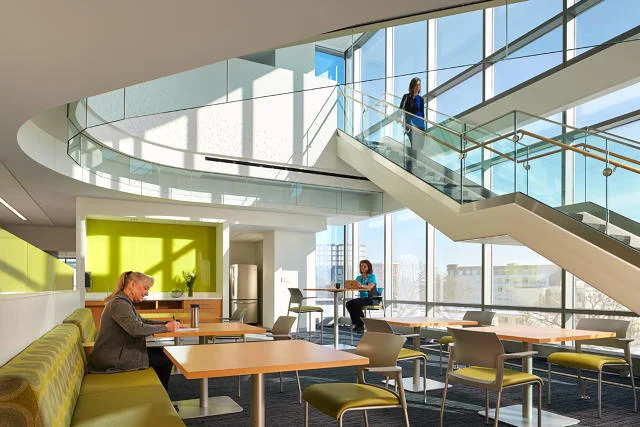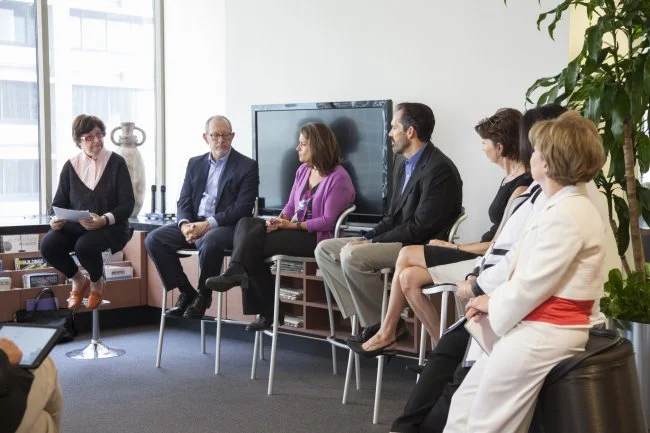It’s no secret that technology has done amazing things for our health and well being. Technological advances have brought us new treatments, medicines, and helped us live healthier, longer lives. On the flip side, technology may also hinder interactions between doctors and patients, as well as caregivers and colleagues. The same technology that helps providers deliver better and faster treatment may also be decreasing face time with their patients. Think back to your last visit to a healthcare clinic. How many times did your healthcare providers use some sort of computer device? It adds up to a lot of screen time which ultimately results in less time focused directly on patients.
What Health Care Designers Can Learn From The Apple Store
It's not often that an architect gets to reimagine the future of health care. But presented with the rare opportunity to build an entire health center from the ground up at a new clinic and surgery center in Minneapolis, the University of Minnesota Health, or M Health, decided to completely upend how it thinks about patient experience and up the ante against its competition—and it enlisted CannonDesign to help.
"If you look at M Health, you have a 'small' competitor due south called the Mayo Clinic," Michael Pukszta, leader of CannonDesign's health care practice, says. "When you look at who you’re going up against—what is recognized as the finest clinic—the task is pretty large. It’s like a new computer company going up against Apple."
Could Standing Enhance the Patient Experience?
It’s no secret that height-adjustable desks and stand up workstations are becoming more and more popular in the workplace. We’ve seen the positive data surrounding the physical benefits to our health. These include increased circulation, improved mental clarity and burning more calories. But, does this translate to a healthcare clinic setting?
Introducing Node with ShareSurface for Exam Rooms
Going to the doctor is one of the most personal and vulnerable experiences we have. Patients want to connect with their doctors and develop a relationship of mutual trust and understanding. At the same time, doctors desire to be consultative, expert guides. These are relationships that require trust, understanding and education, qualities that take time to build and strengthen.
Designing Healthcare Spaces To Support Healthy Lifestyles
Traditionally when people have thought of a healthcare facility, they’ve envisioned an uninviting environment where you go when you’re sick. But health facilities are working hard to change that image as they promote healthy lifestyles. Today, health systems are beginning to focus more on becoming wellness destinations—convenient places that the public wants to visit to proactively manage their health.
Allseating partners with Nursing Institute for Healthcare Design
At the beginning of 2016, Allseating became an Industry Partner of the Nursing Institute for Healthcare Design (NIHD). A non-profit founded ten years ago, NIHD aims to integrate clinical expertise and planning into the design of healthcare environments—specifically through the involvement of experienced nurses.
Working Smarter and Sleeping Better: Circadian Rhythm in Workplace and Healthcare Design
On October 14, 2015, Susan S. Szenasy, Metropolis publisher and editor in chief, was in Seattle as part of the Metropolis Think Tank series to discuss both the need to consider circadian rhythm in workplace and hospital environments as well as the importance of understanding biophilia as a systems approach. What follows is an edited transcript of that conversation, prepared by Dora Vanette, with architects and designers at ZGF Architects LLP, their client, Seattle Children’s Hospital, and their colleagues and research partners at the U.S. General Services Administration (GSA) and the University of Washington. Think Tank 2016 is in full swing--early this June we’ll be in Washington DC.
The Changing Needs of Caregivers, Patients, and Families in Healthcare Design
Throughout 2015 Metropolis’s publisher and editor in chief Susan S. Szenasy visited leading architecture and design firms across the country as part of the Metropolis Think Tank series of discussions on key issues surrounding human-centered design. On August 27, she talked with the principals of WHR Architects, the Houston-based healthcare practice group of EYP Inc., as well as the clinical and operational healthcare experts they invited to participate in the discourse. They focused on the changes in healthcare and the process of designing healthy environments, for patients, their families, and clinicians alike. What follows is an edited transcript of the conversation.
Commentary: Integrated approach is a best practice in health facility development
There’s no longer room for complacency in healthcare. As health organizations’ profit margins have weakened and budgets have tightened over the past decade, leaders must bring laser focus to operations, costs and efficiencies. Typical hospital profit margins are currently around 2%, but leading advisers suggest those could drop significantly into the red over the next 10 years without significant change.
The Changing Needs of Caregivers, Patients, and Families in Healthcare Design
Throughout 2015 Metropolis’s publisher and editor in chief Susan S. Szenasy visited leading architecture and design firms across the country as part of the Metropolis Think Tank series of discussions on key issues surrounding human-centered design.
Designing The Healthcare Workplace
At its core, any healthcare building is a workplace. So what are the basic elements and best practices behind making that workplace a high-performing one? A panel of designers shared some ideas Monday at the ASHE PDC Summit in San Diego.
U.S. Lodging Industry Forecasted to Achieve Record Occupancy in 2016
According to CBRE Hotels’ Americas Research, the U.S. lodging industry is forecast to achieve another all-time record occupancy level in 2016, projecting a year end level of 65.7 percent, 20 basis points greater than the record level of occupancy achieved in 2015. The data was reported in the March to May 2016 edition of Hotel Horizons.
Internet of Things takes on workspaces, hospital care, transportation
Here are some other new applications of Internet of Things technology from Michigan companies.
Early trends in healthcare for 2016
The future of health and healthcare delivery is happening at lighting pace. Just more than a month into the New Year, there are numerous new efforts and developments spanning cancer care, medical research, health education that are both inspiring and exciting. Given our firm’s diversity, almost all of these efforts impact what we focus on with our clients, partners and internal teams.
Florida’s Hospital Construction Boom: Part 1
There’s an often-told old joke about Florida: instead of the northern mockingbird, the official state bird should be the construction crane. In recent years, flocks of these steel towers have nested over hospital building sites in nearly two dozen communities throughout the state. What forces are driving this migration to hospital construction?
IIDA DESIGN WATCH: 3 TRENDS IN HEALTHCARE DESIGN
Healthcare design has been around for years, but there’s no doubt it is a hot topic at this very moment. With the passing of the Affordable Care Act, the rise of technology, and the expectation that wellness is imperative in the workplace, healthcare design is decidedly important now more than ever. We sat down with our very own Cheryl S. Durst, Hon. FIIDA, LEED AP, to see what the healthcare design forecast for 2016 – and beyond – looks like.
Designing Places with Purpose
While we can appreciate the beauty of the buildings we create and the intelligence of the systems we define, ultimately these things are only successful if they help the people who will use them. Creating successful schools and hospitals is not simply about designing modern facilities with cutting-edge technology. It’s about listening to the pulse of the community that needs these spaces. Understanding its challenges, its economy, its health outcomes, its fundamental needs – and delivering the right solution for that specific community.
Designing Behavioral Health Facilities for Privacy
With passage of the healthcare law providing increased coverage for behavioral health services, treatment services for substance use disorders are being integrated with general healthcare. Many healthcare organizations are including spaces for outpatient behavioral health within primary care clinics, and the growing public awareness of addiction as a disease is helping to lessen the associated stigma of getting treatment. However, the need for privacy and discretion, for both legal and clinical reasons, remains integral to a patient’s experience as more outpatient facilities open within multi-tenant buildings, often in highly visible, urban areas. As such, several key design elements can help protect privacy.
Three Healthcare Trends Influencing Design
Current healthcare design trends grow out of the needs of patients, their families, and healthcare professionals. Tangram Interiors integrates these three trends into its collaboration with clients: residential warmth, infection control, and bariatric care.
Mayo Clinic's breakthrough research lab puts evidence-based design to the test
There’s been a lot of talk over the past 20 years about evidence-based design. EBD is the idea that improvements to the design of buildings, particularly to their interior spaces—more daylight, improved air quality, better lighting—can have a positive effect on human health and performance. The problem with EBD is that it’s very hard to conduct truly rigorous scientific studies on humans. Was it the improved lighting that enabled students to boost their test scores, or was it better airflow in the classroom? Did that hospital patient heal more quickly because she had a window with a view to the outside, or was she just a fast healer? Too many variables, not enough controls, so it’s anybody’s guess how much, if anything, the design contributed to the outcome.

























